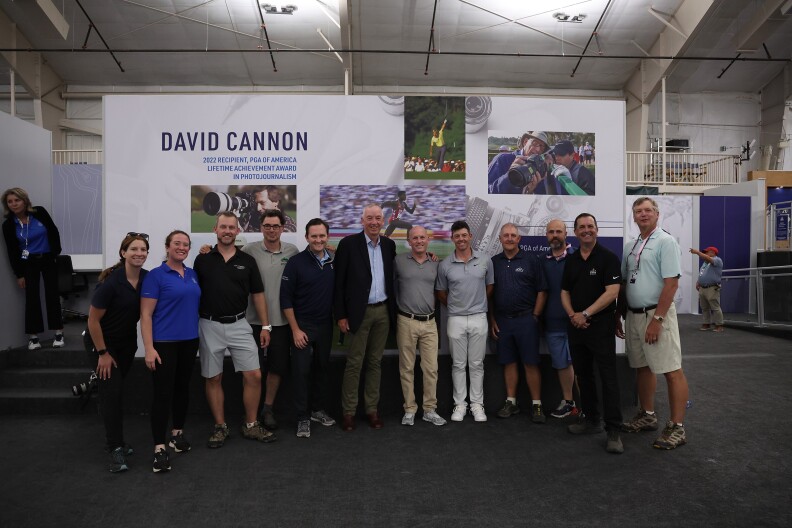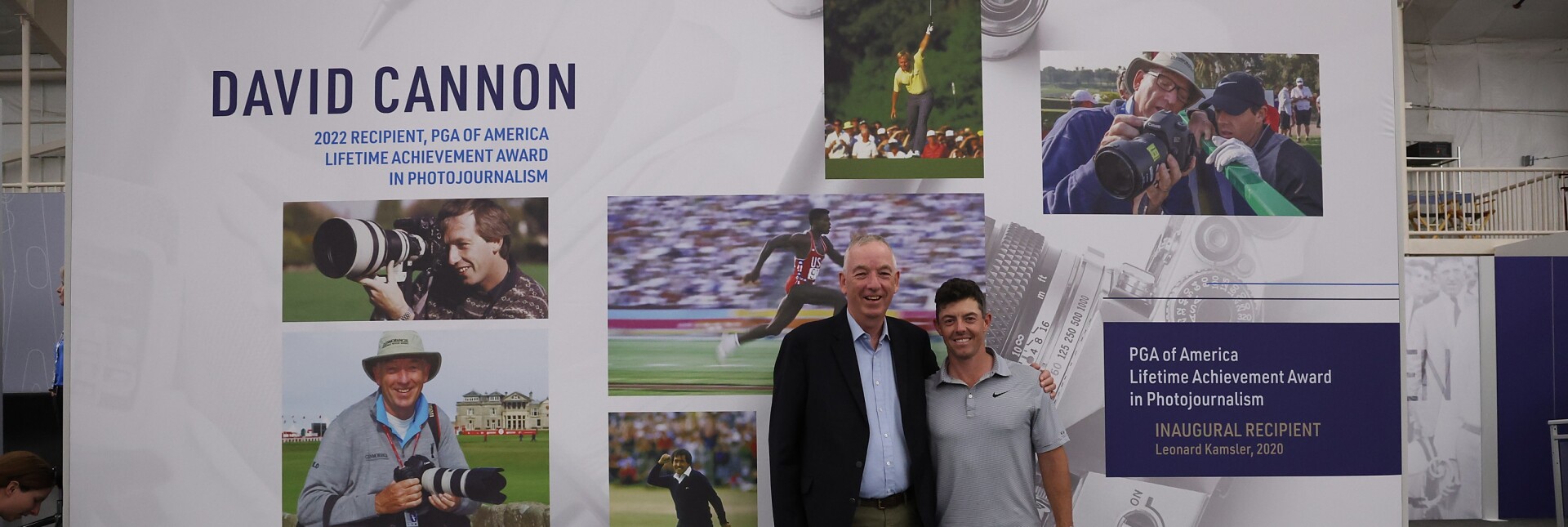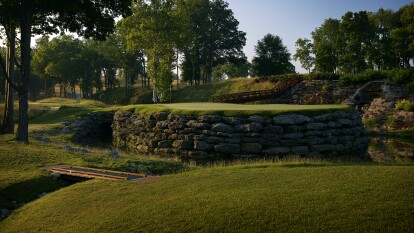David Cannon was asked to look after the cameras belonging to a family friend at a rugby match between Midland Counties and the famed New Zealand All Blacks in Leicester, England, some 44 years ago. What a fortunate night that would turn out to be for golf, and for sports photojournalism as a whole.
Cannon decided to shoot a few frames himself from the corner of the field, shooting about a roll and a half of film, or 50 frames. When one of his pictures ended up atop a story in the Sunday Express, it started the magnificent career of one of sports’ foremost photojournalists, a man who has left an imprint with indelible images that often tell a story much more powerfully than words ever could.
Cannon, 67, whose keen eye for capturing a moment has produced some of the most iconic photos in golf history, received the PGA of America Lifetime Achievement Award in Photojournalism Wednesday at the 104th PGA Championship at Southern Hills Country Club. Cannon is the second recipient of the award that celebrates the importance of photography, following in the footsteps of the late Leonard Kamsler, who was a longtime friend of Cannon’s.
The family friend who took Cannon to that first rugby game was a photographer named Neville Chadwick, who came out of the darkroom as he readied to send rugby photos to New Zealand and held up the film that Cannon had shot. “This is a nice picture here,” he told him. Once the photo appeared in the Sunday paper, Cannon, who had been working as a nylon sheet salesman, was so hooked on shooting sports that he would work the next three years at Leicester Football Club soccer games and Leicester Tigers rugby games, free of charge. Chadwick proudly watched Cannon’s career take hold, and imparted wisdom that Cannon still carries with him.
“He told me to focus on the eyes, and fill the frame,” Cannon said. “Brilliant tips, to this day. The first thing, when anyone looks at a picture, your eyes are drawn to the eyes of the subject. It’s a really critical thing.”
Cannon was a promising golfer as a junior, and wanted to pursue the game professionally one day. He grew up playing English youth events alongside future European Tour standouts such as Nick Faldo, Sandy Lyle and Mark James. Though Cannon has shot nearly all sports all over the world, he always has had an affinity for golf, and that passion – and understanding of the game – shines through in his work.
“I’m biased, but I think a photograph can be more powerful than video,” Cannon said. “It’s a split-second that you’re looking at. A picture can tell a story that 20 minutes of video cannot.”

Through Cannon’s eye, and his lens, and the strong relations he has built with players through the years, the world of golf has been treated to shots such as Seve Ballesteros’ celebratory sequence on the 18th green at St. Andrews in 1984; Jack Nicklaus making birdie at 17 on Sunday of the 1986 Masters; and Carl Lewis racing to gold at the 1984 Olympics in Los Angeles; and Ernie Els sitting in a locker room with the Claret Jug after winning the Open Championship in 2012.
In all, Cannon has covered more than 700 golf events, which include his 123rd men’s major championship this week at Southern Hills; 71 women’s major championships; and 17 Ryder Cups. He has worked 39 Open Championships and hopes to get to 50, he said, as long his legs and back and eyes are good.
He loves shooting at the Masters, and says the Ryder Cup is his favorite event. While a photographer might go six months without a single great celebration photo in a regular tour event, the Ryder Cup is passion-filled, and a dream to shoot. The emotion in players is there from the very first tee on opening day.
Cannon’s background in the game allows him to see images as they develop, and to be in the right place. “I tried to photograph golf as a golfer,” he said. “I love impact pictures.”
Cannon was honored Wednesday evening inside the clubhouse at Southern Hills as part of the 104th PGA Championship, and took part of a Q&A session that was hosted by CBS’ Jim Nantz. Cannon’s career has been forged by lots of hard work – shooting golf tournaments can require walking five or more miles a day, for seven days, toting 35-pound cameras on one’s shoulder – but there also has been an element of good luck.

Before he walked from the Media Center to the clubhouse, Cannon was stopped by Rory McIlroy, who congratulated him on his lifetime achievement recognition. Cannon first took photos of McIlroy when McIlroy was only 13. He got a tip from an agent that he needed to fly to South Africa one year to shoot a hot up-and-comer, and he did, meeting Ernie Els when Els was just a teen. He might not have a closer relationship among players.
He even had the fortune of a pro-am pairing at his home club in 1976 when he drew a young unkown Spaniard named Seve Ballesteros. The two became great friends. One of Cannon’s greatest photos is a picture of a smiling Ballesteros at home in Spain on the beaches of Pedrena, where he learned the game. Ballesteros even recreated how he would build a hole, using a soup can planted into the sand, and a makeshift flag.
“David Cannon’s choice images have long served the game of golf as historical markers that will allow the greatest stories to be shared in the visual in perpetuity,” said Jim Richerson, President of the PGA of America.
Cannon, an unfailingly polite man who has many friends, looked around the ball room at Southern Hills Wednesday evening and wished to thank so many who helped him in his incredible journey. He could not help but think of Chadwick, the man who got him started all those years ago. Chadwick would be thrilled every time that Cannon finished a book and sent an early copy his way. Sadly, Cannon was on his way to Augusta last month when he got a phone call informing him that Chadwick passed away.
His voice cracking, Cannon said, “He would be so proud tonight.




